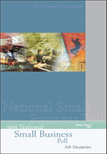Job Vacancies
• Though the economy was trending downward in the latter half of 2007, 17 percent of small employers reported one or more job vacancies. Forty-two (42) percent of those currently employing 20 or more people had at least one. The plurality (47%) with a vacancy had only one while 21 percent listed two and 30 percent three or more. Of those without a current job vacancy, 43 percent had at least one in the six months prior to the survey.
• The types of jobs vacant in small businesses varied substantially, ranging from openings for the highly skilled to the unskilled. Examples of job vacancies included: pharmacist, CPA, laborer, chef, software engineer, bartender, driver, sales clerk, golf pro, warehouseman, appliance technician, cashier, mechanic, real estate agent, and mason’s helper.
• The profile of the current job vacancy, or most recent hire among those without a current vacancy, is/was: a full-time rather than a part-time job (65% vs. 34%), a permanent rather than a seasonal or temporary job (78% vs. 22%), a replacement for a departed employee rather than a new position (59% vs. 40%), and a job with promotion possibilities rather than one without them (59% vs. 41%). The median starting wage for the opening is/was $12.50 per hour with 31 percent of firms augmenting employee income with tips, bonuses, and commissions, and 40 percent with health insurance.
• Job vacancies in small businesses were more likely to require experience than not. Fiftyseven (57) percent of small employers with a vacancy required some prior experience. Another 20 percent preferred it. Experience did not matter in 23 percent of cases.
• The most common form of recruiting to fill a small business position was spreading notice of the opening by word-of-mouth (79%). Almost as frequently used was requests of current employees to help locate an employee(s) (65%). Twenty (20) percent placed a job listing on the Internet.
• Small employers typically met few qualified job applicants from which to choose. Fiftysix (56) percent had just a “few” qualified applicants and 10 percent had “none.” In contrast, 9 percent had “lots” of qualified applicants and another 21 percent had “some.” The most frequently cited reasons for the small pool of qualified prospective employees were the lack of experience (40%) and the lack of occupational or job skills (14%).
• Omitting experience, the lack of job-specific or occupational skills, a poor job and/or work history and inflated wage and/or benefit expectations were the most typical problems small business employers found in the pool of applicants they evaluated.
• Forty-six (46) percent of small employers always ask for and check out the references of the people that they plan to hire. Another 24 percent usually do. Only 12 percent either infrequently ask for or check references, or never do.
• Employers are required to complete an I-9 form for all employees hired. Six percent of small employers have had a government official ask to see an I-9 in the last three years.


